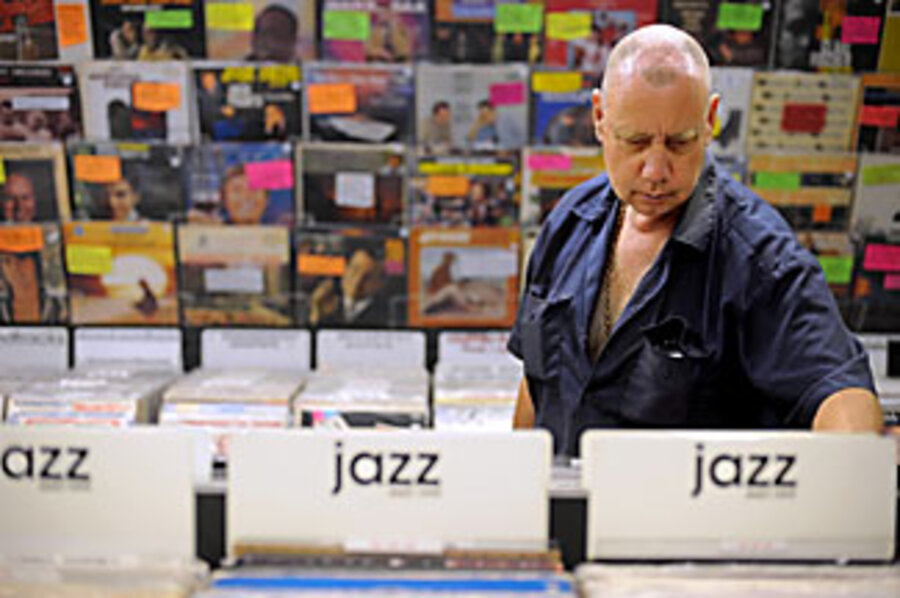Young indie crowd takes vinyl for a spin
Loading...
| Brooklyn, n.y.
A few years ago, under pressure from spiraling rent costs, Jeff Loos shut his storefront in downtown Lincoln, Neb., and moved Backtrack Records onto the Web. The plan: Lower the overhead and increase reach. The outcome: a spike in vinyl sales, and a surge in new customers from as far away as Australia and Estonia – "that's in Eastern Europe," Mr. Loos says proudly – and as close as the next block.
By May 2007, business was sturdy enough for Loos to reopen a small brick-and-mortar store on North Cotner Boulevard. (He still maintains an online presence, at backtrackrecords.com.) By his estimate, Loos has since unloaded about 40 turntables and thousands of vinyl records to customers across a wide spectrum of tastes.
"It's crazy," says Loos, in an affable Nebraska drawl. "It's the young kids buying, the ones listening to the indie rock; and it's the older folks, the ones that want the box-sets; and it's the audiophiles; and it's everyone else who's stuck in the middle. I'm not saying there's a turntable in every house in the neighborhood, but vinyl is definitely having a resurgence."
According to the Recording Industry Association of America, a national trade group, shipments of CDs dropped precipitously between 2006 and 2007, losing a long battle with digital sales. At the same time, shipments of vinyl rose a remarkable 36 percent, leveling off at 1.3 million units.
That figure was a happy surprise for retailers such as Loos and Jason Figel, the owner of Music Matters, a record store in the Park Slope section of Brooklyn, N.Y. On a recent afternoon, customers shuttled in and out of the cozy 7th Avenue space, rifling through a stack of vinyl that Mr. Figel says he regularly replenishes.
"It's pretty incredible," Figel smiles. "And there seems to be a real willingness on the part of labels to put out more material on vinyl – a lot of the time with some sort of tie-in." He points specifically to the self-titled debut from the folk-rock band Fleet Foxes. The vinyl edition of "Fleet Foxes" goes for about $16; it includes a code for a free digital download of the album. Here in Brooklyn – ground zero for many hipster collectors – Figel can't keep it on the shelves.
For big-name labels such as EMI, which has watched its revenue slip in recent years, the interest in vinyl is welcome news. In July, EMI and its subsidiary, Capitol Records, announced the launch of a campaign called "From the Capitol Vaults." According to Jane Ventom, vice president of artists & repertoire and creative at EMI Music Marketing, the campaign will include 13 "classic" albums, all of which are currently out of print on vinyl. Included in the treasure trove: "Pet Sounds," by the Beach Boys; "A Rush of Blood to the Head," by Coldplay; and "OK Computer" and "Kid A," by Radiohead, both of which will be released as 10-in., 140-gram LPs.
"It's a bit of a novelty thing. It's a bit nostalgic," says Ms. Ventom. "I'm not sure the interest will continue forever. It will probably level off. But for now, you're getting these consumers who have never been exposed to the artwork on a [record cover], or to that unique experience of listening to vinyl, with that crackle and pop. There's a real consumer demand."
That demand is coming from two directions, says Loos, the owner of Backtrack Records. On the one hand, you've got diehard audiophiles, who see nothing wrong in forking over $30 and up for a high-quality disc. For these customers, Loos says, "vinyl never went away. It's a question of digital versus analog," or an MP3 and that crystalline vinyl sound. "Digital is compressed, binary – it's in bits. You just can't equal the sound of a good record. They're trying," Loos adds with a laugh. "But you can't do it."
On the other hand, you've got young listeners – kids in their 20s and 30s who may have inherited a turntable from their parents, and are deep into indie rock and pop. "They'll come in and say, 'Man, this is much better than a CD,' " Loos says, "and pretty soon, they're in here buying records."
Indie labels, accordingly, have begun to amp up their vinyl releases. Brendan Canning, a member of Broken Social Scene, says every one of the Canadian band's records has seen an LP release. Mr. Canning recently finished his own album, "Something for the Rest of Us," and conceptualized the artwork specifically for the bigger canvas of a record sleeve.
"CDs never really resonated with me," says Canning, who estimates his own vinyl collection at 1,200 albums. "I like a big piece of artwork – I really appreciate that," he adds. "And of course it just sounds better. It takes you to a place that CDs can't."
His latest purchase? "Oh man, let me tell you about this," he says. "It's 'Every Mouth Must be Fed 73-76,' a reggae collection. It's got this great white cover with green ink. Can't get enough of it."






